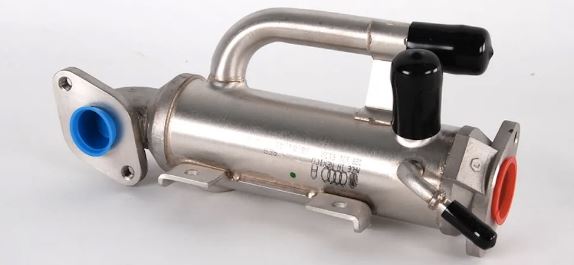Imagine taking your car in for a service after experiencing some difficulties, and the mechanic telling you that your car has suffered “EGR cooler failure.” If you hear that, would you know what exactly the mechanic was talking about? Do you know what the EGR cooler does? Do you even know what EGR stands for? If not, then today’s blog should be a big help to you.
What Does EGR Mean?
The exhaust gas recirculation coolers (known more often as simply EGR coolers) are special devices that help to cut down on the harmful NOx (nitrogen oxide) emissions on internal combustion engines. In the modern context of stricter and stricter emissions regulations, they are a more important component than ever, especially in diesel engines.
What Does an EGR Cooler Do? How Does it Work?
The EGR cooler works to actively cut down emissions levels by first diluting the air/fuel mixture in your engine using inert exhaust gas. These inert gasses have very little impact on the way your engine performs, but at the same time they dramatically reduce the chances of harmful exhaust fumes being produced in the first place.
The EGR cooler sits in between the turbo and the EGR valve, its body a hollow tube (or multiple tubes) along with a number of passages for coolant. Heat comes through the walls, which separates the exhaust and coolant, which brings inter exhaust gasses that enter the mix and lower the peak combustion temperature. The EGR valve controls the flow, with the valve itself being managed by the vehicle’s on-board computer.
What Causes EGR Cooler Failure? What are the Symptoms?
The chief cause of failure in an EGR cooler is internal cracks. The good news is that there are no moving parts in the component, which means other more complex wear and tear doesn’t happen like it might in a turbo or in your transmission. However, the persistent cycle of cooling and heating eventually takes its toll, creating fatigue on the material and eventually creating cracks and small fractures.
Symptoms of EGR Failure
Dropping Coolant Levels
If you notice that there is coolant in the overflow bottle, or that your engine is otherwise consuming coolant, then it’s a classic sign that your EGR cooler has fractured. The cracks cause coolant to start seeping out and mixing with the exhaust stream.
White Smoke
Check (or ask a friend to help) to see if you can see white smoke coming out of your exhaust. If you can see white smoke, it’s most likely being caused by leaking coolant getting into the exhaust stream, combusting and then vaporizing, creating the white tint you see in the smoke.
Inspection Reveals Damage
Locate the EGR valve and remove it. If you see that it’s wet, or has been apparently steam cleaned, or that it has become gummed up, then these are all possible results of problems within the EGR cooler itself.
Can You Clean the EGR Cooler? How?
To replace the EGR cooler is fiddly and therefore quite often expensive work for a professional mechanic to do. Therefore, it’s better to leave the replacement of your EGR valve as a measure of last resort. The first thing you should try to do is to clean it.
To be clear, cleaning the EGR cooler will not fix fractures or cracks. Cleaning the EGR cooler should be seen as a preventative measure that can help prolong its life and avoid you having to spend the money required to replace it. The following is a quick step by step guide to cleaning:
Step 1: Turn Off, Open Hood, Locate
The first steps are to ensure your vehicle is switched off and the engine cool. Pop the hood open and locate first the air intake hose and intake manifold hose. Both of these need to be removed. You’ll likely find them on the side of the engine.
Step 2: Unplug
Next, you need to unplug the PVS heating element, and then the intake manifold’s change-over valve. These are held in place by hex bolts.
Step 3: Remove
With the bolts and change-over valve out, you can remove the vacuum lines from the EGR and anti-shudder valve, along with the hex bolt and clamp that are holding the turbo intake pipe in place. The EGR itself is likely bolted, so you’ll need to remove those.
Step 4: Spray and Plug
Now you have access to the EGR, you can begin the cleaning steps. First of all, spray hot water into the EGR’s internal cavity for about 10 minutes in total. Afterward, use a rubber plug to block the EGR cooler outlet.
Step 5: Mix and Fill
Mix up your EGR system cleaning fluid as instructed by the manufacturer on the packaging. Typically it’s about 4 parts hot water and 1 part cleaning fluid. Fill up the EGR with the cleaning solution.
Step 6: Wait
After filling, wait for an hour to let the solution soak and do its work.
Step 7: Drain, Rinse, Dry, Restore
Remove the plug to allow the EGR to drain out, ensuring that you’re not breaking any local rules by allowing it to escape into the wrong drains. Rinse the EGR with hot water again and then dry it off. Put everything back as it was before you started and you’re done!
What is Involved in EGR Cooler Replacement? How Much Does it Cost?
Fully disconnecting the EGR involves a much wider process including disconnecting battery cables, draining coolant from the radiator, and carefully removing the whole thing in full before restoring it all with a new component. The job typically takes 2-3 hours to complete, and will end up costing you about $300 at the low end of the spectrum.
If you’re having the EGR replaced in a high-specification car, then it can cost as much as $3,000 to get the job done. That’s why cleaning is the better alternative if possible to prolong the unit’s life and put off having to replace it for longer. When used correctly and when properly cleaned, it should last for 80,000 miles, and possibly longer.
Go Home








